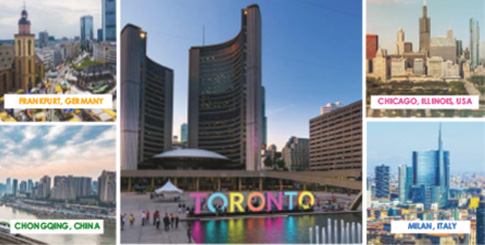Rubini points out another difference: the CIPM supports local growers, with wholesalers buying local whenever possible in season, while the OFT has a separate section of the market that houses local growers on the premises. The OFT’s 8-acre farmers’ market is home to 350 tenants and 550 stalls.
Because Chicago and Toronto are both home to bustling produce markets, the two cities are steady trade partners. “We haul a significant amount of product between Chicago and Toronto,” confirms Rubini. “Each market does the same job, but in a slightly different way.”
THE EVOLUTION OF SISTER CITIES
In an effort to foster cultural understanding, camaraderie, and economic growth, many metropolitan areas are paired with ‘sister cities’ across the globe. Pairings are officially recognized by the highest elected or appointed official of both cities, and forged with a signed agreement. Often called ‘twin towns,’ the pairings are designed to bring the world closer through commercial and cultural ties, social interaction, and mutually beneficial partnerships.In Europe, the sister city concept can be traced as far back as 836 A.D., with the earliest pairing between Paderborn, Germany and Le Mans, France. North America’s first sister city agreement was established between Toledo, Ohio and Toledo, Spain in 1931. Then in 1944 Vancouver, British Columbia formed a sister city partnership with Odessa, Ukraine after Canada provided aid to the allied port city during World War II.
The concept gained steam in the United States in 1956 with President Dwight D. Eisenhower’s citizen diplomacy initiative, Sister Cities International, to champion “peace and prosperity by fostering bonds between people from different communities around the world.” Today, the nonprofit oversees more than 2,000 partnerships spanning 145 countries on six continents.
Julian Sarraino, vice president of marketing and sales for Fresh Taste Produce Ltd. on the OFT, believes the sister-city partnership is beneficial. “We have many connections in Chicago and maintain close ties with our colleagues regarding market conditions.”
Sagamihara, Japan (friendship; 1991)
Located in north central Japan, Saga-mihara is the fifth most populous suburb in the greater Tokyo area with an estimated population of almost 722,000—quite a bit smaller than Toronto.
Sagamihara’s climate is temperate and rainy, with average annual rainfall of more than 61 inches. Toronto’s annual rainfall is half of Sagamihara’s at about 30 inches, as the bulk of its annual precipitation is in crystallized form, at about 45 inches of snow per year.
Sagamihara is well known for its industrialized economy, with a focus on manufacturing and food processing. Beyond the metro area, the city’s surrounding agricultural region produces rice and wheat, with no commercial production of fruit or vegetables in the area.
About 250 miles north, however, is Miyagi Prefecture—home to the world’s largest indoor farm in an abandoned Sony facility. This massive hydroponic “plant factory” harvests about 10,000 heads of fresh lettuce each day.



